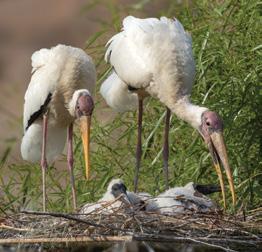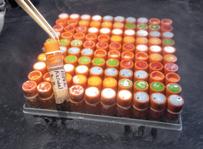
2 minute read
Findings
San Diego Zoo Wildlife Alliance pursues wildlife protection strategically by focusing on eight conservation hub regions on six continents. Below are recent discoveries and progress from around the world.
MILKY STORKS AT THE SAFARI PARK
In March 2021, 23 milky storks Mycteria cinerea arrived at the Safari Park to start a breeding population for this critically endangered species. Habitat destruction and illegal trade have decimated the milky stork population in their native habitat in Southeast Asia. The Safari Park has been the only facility in the United States to produce surviving milky stork offspring in the last decade. All milky storks under human care in North America were brought together as part of a critical move by SDZWA and the Audubon Zoo to establish a breeding population.
NEW TECHNOLOGY SUPPORTS TASMANIAN DEVIL CONSERVATION SDZWA scientist Carmel Witte, Ph.D., is migrating a computer simulation model from the Compute Canada Supercomputer over to the UCSD Supercomputer Center. This computationally intensive simulation model evaluates treatments for devil facial tumor disease, a deadly and contagious cancer that has driven Tasmanian devils Sarcophilus harrisii to near extinction. Carmel will develop a graphical user interface to make interaction with the innovative technology more userfriendly for SDZWA and our collaborators.
SDZWA PARTNERS WITH WILDAID TO SAVE EBO FOREST San Diego Zoo Wildlife Alliance has partnered with WildAid, a San Francisco-based conservation organization working with governments to stop illegal wildlife trade. WildAid has created a multi-platform media campaign, including a sevenminute documentary highlighting the Ebo Forest Research Project. The SDZWA African forest hub team gathered pictures of endangered and critically endangered wildlife in Ebo Forest, Cameroon, including a rarely seen gorilla population and NigeriaCameroon chimpanzees Pan troglodytes ellioti. The documentary, La Forêt d’Ebo, follows conservationists advocating local government protection for the forest. The film was supported by several organizations, including SDZWA, WildAid, Ebo Forest Research Project, and Ape Action Africa.
WILDLIFE BIODIVERSITY BANK GAINS A NARWHAL
After over two months in culture, cells from a female narwhal Monodon monoceros were recently added to SDZWA's Biodiversity Bank. These cells, a first for SDZWA, will help preserve the genetic diversity of this vulnerable species. The samples were collected in Pond Inlet, Canada, in collaboration with the Narwhal Genome Initiative. Other Canadian collaborators included the Museum of Nature and National Biodiversity Cryobank, and the Wildlife Office, Pond Inlet.


OCTOBER 1–3, 8–10, 15–17, 22–24, AND 29–31
Our popular October event is back, and bigger than ever! Join us weekends—all month long—to help us light up the night until 9 p.m.! Kids 11 and younger are free, and may come in costume.
There is fun for the whole family, with musical entertainment, dance parties, special performances, and more— plus Dr. Zoolittle, Zoo characters, and tempting food specials.







